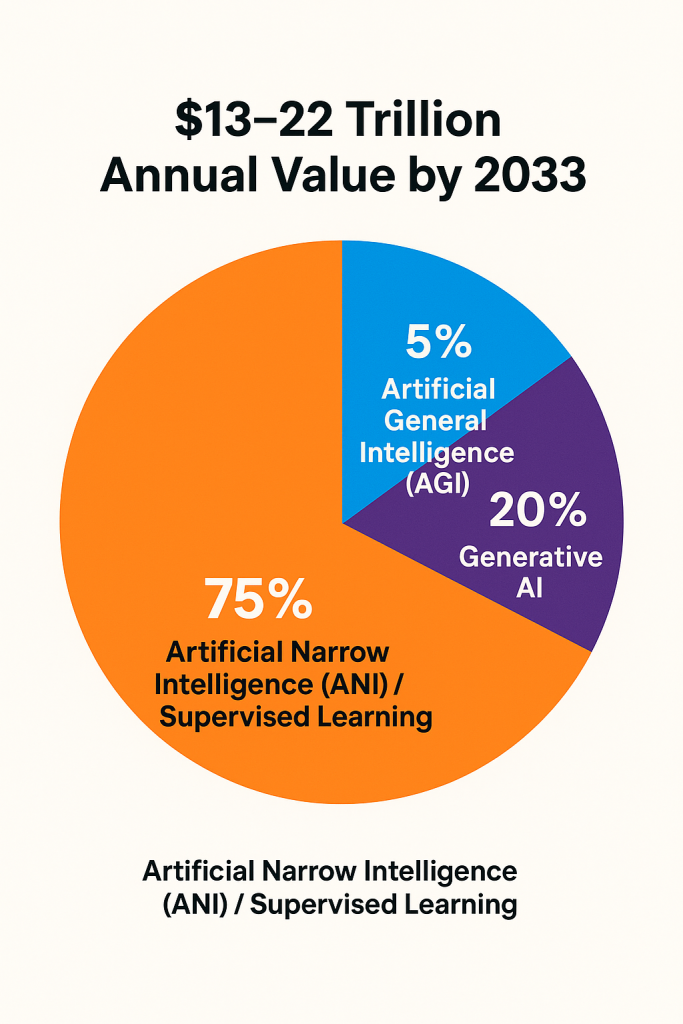There’s no doubt that Artificial Intelligence (AI) is the technology of our time, promising to reshape industries and create unprecedented economic value. But beneath the headlines and hype, what exactly is driving this revolution, and where is the estimated $13 to $22 trillion in annual value going to come from by 2033?
The source for this valuation is a landmark 2018 report from the McKinsey Global Institute (MGI) on the impact of AI on the world economy. You can find the full details of this modeling here: Notes from the AI frontier: Modeling the impact of AI on the world economy.
The answer requires demystifying AI and understanding its three core ideas.
The Three Faces of AI

The term “AI” can be confusing because it refers to three distinct concepts:
Artificial Narrow Intelligence (ANI)
Artificial Narrow Intelligence (ANI) is the powerhouse driving the vast majority of AI value creation today. Unlike the broader, theoretical concept of human-level AI, ANI refers specifically to focused AI systems designed to master one specific task incredibly well. These systems are essentially “one-trick ponies,” but when the trick is appropriately chosen, the resulting impact is transformative and lucrative. Common examples include –
- the spam filters that protect your inbox
- the algorithms that power object detection in self-driving cars
- the smart speakers that recognize your wake word, and
- the automated visual inspection systems used in manufacturing to spot tiny defects in products coming off the assembly line.
This high-impact, focused nature is why studies, such as those by the McKinsey Global Institute, consistently suggest that the largest portion of the projected multi-trillion dollar future value of AI will be unlocked through these narrow, yet highly optimized, applications, frequently relying on the machine learning technique known as Supervised Learning.
Generative AI (GenAI)
Generative AI, or GenAI, is absolutely the newest superstar in the tech world. This kind of AI has rapidly become famous because it can produce amazing, high-quality content—things like coherent text, realistic images, and even audio. It’s fundamentally expanded what we thought AI could do. For instance, tools like ChatGPT aren’t just single-task programs; they can jump between being a helpful copy editor, a creative brainstorming partner, or a concise text summarizer all in one go. Even though GenAI grabs a lot of headlines, it’s expected to account for a smaller, but still massive, slice of the total economic pie, we’re talking about $4 trillion annually. Its success is blurring the lines, making it seem like the previously narrow AI (ANI) can now handle much more general-purpose tasks.
Artificial General Intelligence (AGI)
Artificial General Intelligence, or AGI, is the stuff of science fiction. It’s the big dream: creating an AI smart enough to handle any intellectual task a person can do, maybe even becoming super-intelligent, capable of far more than any human. But here’s the reality check: we are still very far away from achieving AGI. The recent exciting and valuable steps we’ve made with narrow AI (ANI) and generative AI (GenAI) are impressive, sure, yet they often trick people into thinking AGI is right around the corner. Instead, it’s better to think of our current progress as tiny, promising baby steps leading toward what is still a distant, long-term goal.
Beyond Software: Where AI Will Strike Next
AI has definitely already created tremendous value in the world of software. But we must understand that the biggest future opportunities, the most exciting part actually lie outside of the tech sector itself. We’re talking about massive transformation coming to industries like retail, travel, transportation, manufacturing, and the automotive sector. Seriously, it’s really hard to name one single industry that won’t be hugely impacted by this technology in the next few years. The real trick, the big challenge for companies that don’t build software, is figuring out exactly which specific, narrow “tricks” those powerful, focused AI applications (ANI) can use to unlock this huge, multi-trillion dollar potential right within their own daily operations.


Leave a Reply